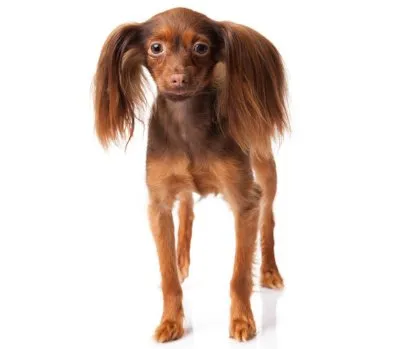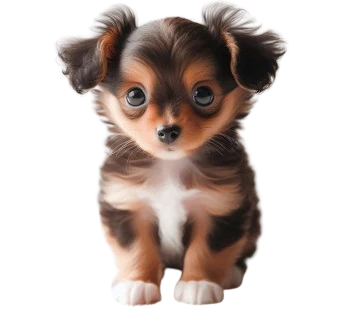
The Russkiy Toy, sometimes called the Russian Toy Terrier, is a small dog breed from Russia, known for its elegance and playful temperament. It is distinguished by its lively nature and small size, making it an ideal companion dog for people living in apartments. This dog is especially appreciated for its affectionate nature and loyalty to its owners.
The Russkiy Toy is a small dog, measuring between 20 and 28 cm at the withers, and weighing between 1 and 3 kg. There are two varieties: smooth-haired and long-haired. The long-haired Russkiy Toy has elegant fringes on the ears and limbs, while the smooth-haired variety has a sleek, tight coat. The coat colors can vary: black and tan, blue and tan, brown, or red. Despite its small size, it is well-proportioned with a slender body and large, erect ears that give it an attentive and expressive appearance.
The coat of the Russkiy Toy varies depending on the variety. The smooth-haired Russkiy Toy has a sleek and shiny coat, while the long-haired Russkiy Toy has a silky coat with distinctive fringes. In both cases, grooming is simple: a weekly brushing is enough to keep its coat in good condition.
The Russkiy Toy is a very light dog, typically weighing between 1 and 3 kg, with a height at the withers ranging from 20 to 28 cm. This small size, combined with its slim silhouette, makes it very agile and fast, despite its delicate appearance.
The Russkiy Toy is a lively, joyful, and sociable dog. It forms a deep attachment to its family and shows affection toward its owners. It is a brave dog despite its size, and can sometimes be wary of strangers. However, good socialization from a young age can help temper this trait. It is intelligent and learns quickly, though its independent side may sometimes require gentle but firm training.
In general, the Russkiy Toy is a robust dog, though it can be prone to certain conditions such as patellar luxation, common in small breeds, or dental problems due to the small size of its jaw. It is important to monitor its diet and provide regular physical activity to maintain its health.

The Russkiy Toy Puppy is a small dog breed originating from Russia, known for its lively and affectionate character. This dog is a true ball of energy, always seeking attention and cuddles. Very intelligent, it easily adapts to apartment living thanks to its small size and calm demeanor when well-trained. The Russkiy Toy is loyal and affectionate, particularly attached to its owner. Despite its small size, it is not fearful and can show bravery when needed. It is important to provide a gentle but firm education, as it can sometimes be stubborn. Its silky coat, which can be either short or long, requires regular grooming to avoid tangles.
The price of a Russkiy Toy Puppy depends on the breeder, pedigree, and specific traits of the animal. On average, you can expect to pay between 800 and 1,500 euros for a quality puppy.
The Russkiy Toy, an elegant Russian toy dog with long legs, requires training adapted to its miniature size and lively temperament. Despite its small stature (22-28 cm), this dog has a strong personality and quick intelligence that demand specific methods. Its extreme sensitivity to voice tones necessitates an always positive and gentle approach, without ever raising your voice.
Opt for ultra-short training sessions (5-10 minutes maximum) but frequent (3-4 times daily), as this toy dog has limited concentration span but learns very quickly. Use miniature toys and treats suited to its small mouth to maintain attention. For example: hide kibble under lightweight plastic cups to simultaneously stimulate its intellect and sense of smell without tiring it.
Its developed alert instinct requires specific work on excessive barking. From 3 months, accustom it to recognize "normal" noises (elevator, doorbell) by rewarding silence with gentle petting. Never physical punishment with this fragile breed - simply turning your back generally suffices to show disapproval. Early socialization (from 10 weeks) is crucial to prevent the breed's characteristic excessive timidity.